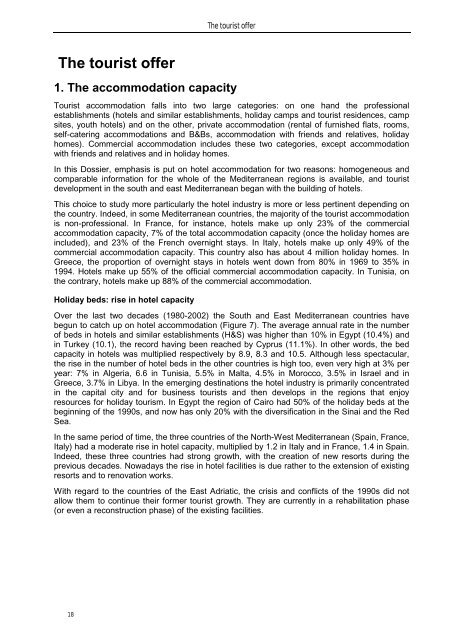dossier sur le tourisme et le développement durable
dossier sur le tourisme et le développement durable
dossier sur le tourisme et le développement durable
You also want an ePaper? Increase the reach of your titles
YUMPU automatically turns print PDFs into web optimized ePapers that Google loves.
The tourist offer<br />
18<br />
The tourist offer<br />
1. The accommodation capacity<br />
Tourist accommodation falls into two large categories: on one hand the professional<br />
establishments (hotels and similar establishments, holiday camps and tourist residences, camp<br />
sites, youth hotels) and on the other, private accommodation (rental of furnished flats, rooms,<br />
self-catering accommodations and B&Bs, accommodation with friends and relatives, holiday<br />
homes). Commercial accommodation includes these two categories, except accommodation<br />
with friends and relatives and in holiday homes.<br />
In this Dossier, emphasis is put on hotel accommodation for two reasons: homogeneous and<br />
comparab<strong>le</strong> information for the who<strong>le</strong> of the Mediterranean regions is availab<strong>le</strong>, and tourist<br />
development in the south and east Mediterranean began with the building of hotels.<br />
This choice to study more particularly the hotel industry is more or <strong>le</strong>ss pertinent depending on<br />
the country. Indeed, in some Mediterranean countries, the majority of the tourist accommodation<br />
is non-professional. In France, for instance, hotels make up only 23% of the commercial<br />
accommodation capacity, 7% of the total accommodation capacity (once the holiday homes are<br />
included), and 23% of the French overnight stays. In Italy, hotels make up only 49% of the<br />
commercial accommodation capacity. This country also has about 4 million holiday homes. In<br />
Greece, the proportion of overnight stays in hotels went down from 80% in 1969 to 35% in<br />
1994. Hotels make up 55% of the official commercial accommodation capacity. In Tunisia, on<br />
the contrary, hotels make up 88% of the commercial accommodation.<br />
Holiday beds: rise in hotel capacity<br />
Over the last two decades (1980-2002) the South and East Mediterranean countries have<br />
begun to catch up on hotel accommodation (Figure 7). The average annual rate in the number<br />
of beds in hotels and similar establishments (H&S) was higher than 10% in Egypt (10.4%) and<br />
in Turkey (10.1), the record having been reached by Cyprus (11.1%). In other words, the bed<br />
capacity in hotels was multiplied respectively by 8.9, 8.3 and 10.5. Although <strong>le</strong>ss spectacular,<br />
the rise in the number of hotel beds in the other countries is high too, even very high at 3% per<br />
year: 7% in Algeria, 6.6 in Tunisia, 5.5% in Malta, 4.5% in Morocco, 3.5% in Israel and in<br />
Greece, 3.7% in Libya. In the emerging destinations the hotel industry is primarily concentrated<br />
in the capital city and for business tourists and then develops in the regions that enjoy<br />
resources for holiday tourism. In Egypt the region of Cairo had 50% of the holiday beds at the<br />
beginning of the 1990s, and now has only 20% with the diversification in the Sinai and the Red<br />
Sea.<br />
In the same period of time, the three countries of the North-West Mediterranean (Spain, France,<br />
Italy) had a moderate rise in hotel capacity, multiplied by 1.2 in Italy and in France, 1.4 in Spain.<br />
Indeed, these three countries had strong growth, with the creation of new resorts during the<br />
previous decades. Nowadays the rise in hotel facilities is due rather to the extension of existing<br />
resorts and to renovation works.<br />
With regard to the countries of the East Adriatic, the crisis and conflicts of the 1990s did not<br />
allow them to continue their former tourist growth. They are currently in a rehabilitation phase<br />
(or even a reconstruction phase) of the existing facilities.
















